Differentiated Spatial-Temporal Flood Vulnerability and Risk Assessment in Lowland Plains in Eastern Uganda
Abstract
1. Introduction
2. Materials and Methods
2.1. Study Area
2.2. Hydrological Modelling
2.2.1. Model Input Data
2.2.2. Model Set-Up and Calibration
2.2.3. Model Performance Evaluation
2.3. Hydraulic Modelling Using HECRAS
2.4. Flood Hazard Analysis
2.5. Flood Vulnerability Analysis
2.6. Flood Risk Analysis
3. Results
3.1. Land Cover Classification in Manafwa Catchment
3.2. Model Calibration, Sensitivity, and Uncertainty Analysis
3.3. Inundation Areas Mapped
3.4. Floodplain Vulnerability
3.5. Flood Risk Analysis
4. Discussion
5. Conclusions
Author Contributions
Funding
Institutional Review Board Statement
Data Availability Statement
Acknowledgments
Conflicts of Interest
References
- Arnell, N.W.; Gosling, S.N. The Impacts of Climate Change on River Flood Risk at the Global Scale. Clim. Chang. 2016, 134, 387–401. [Google Scholar] [CrossRef]
- Cred Crunch. Natural Disasters in 2017: Lower Mortality, Higher Cost; Technical Report; Centre for Research on the Epidemiology of Disasters: Brussels, Belgium, 2018; pp. 1–2. [Google Scholar]
- Mubialiwo, A.; Onyutha, C.; Abebe, A. Historical rainfall and evapotranspiration changes over Mpologoma catchment in Uganda. Adv. Meteorol. 2020, 2020, 8870935. [Google Scholar] [CrossRef]
- Ministry of Water and Environment. Mpologoma Catchment Management Plan; Ministry of Water and Environment: Kampala, Uganda, 2018.
- Floodlist. Uganda—Deadly Floods and Landslides in Eastern Region (Updated). 2020. Available online: https://floodlist.com/africa/uganda-floods-bududa-sironko-december-2019 (accessed on 5 February 2021).
- Pinos, J.; Timbe, L. Performance assessment of two-dimensional hydraulic models for generation of flood inundation maps in mountain river basins. Water Sci. Eng. 2019, 12, 11–18. [Google Scholar] [CrossRef]
- Vojtek, M.; Vojteková, J. Flood hazard and flood risk assessment at the local spatial scale: A case study. Geomat. Nat. Hazards Risk 2016, 7, 1973–1992. [Google Scholar] [CrossRef]
- Alahacoon, N.; Matheswaran, K.; Pani, P.; Amarnath, G.A. Decadal Historical Satellite Data and Rainfall Trend Analysis (2001–2016) for Flood Hazard Mapping in Sri Lanka. Remote Sens. 2018, 10, 448. [Google Scholar] [CrossRef]
- Cao, C.; Xu, P.H.; Wang, Y.H.; Chen, J.P.; Zheng, L.J.; Niu, C.C. Flash Flood Hazard Susceptibility Mapping Using Frequency Ratio and Statistical Index Methods in Coalmine Subsidence Areas. Sustainability 2016, 8, 948. [Google Scholar] [CrossRef]
- Nkiaka, E.; Nawaz, N.; Jon, C. Evaluating global reanalysis datasets as input for hydrological modelling in the Sudano-Sahel Region. J. Hydrol. 2017, 4, 13. [Google Scholar] [CrossRef]
- Gorgoglione, A.; Gioia, A.; Iacobellis, V.; Piccinni, A.; Ranieri, E. A rationale for pollutograph evaluation in ungauged areas, using daily rainfall patterns: Case studies of the Apulian Region in Southern Italy. Appl. Environ. Soil Sci. 2016, 2016, 9327614. [Google Scholar] [CrossRef]
- Liu, G.; He, Z.; Luan, Z.; Qi, S. Intercomparison of a lumped model and a distributed model for streamflow simulation in the Naoli River Watershed, Northeast China. Water 2018, 10, 1004. [Google Scholar] [CrossRef]
- Daniel, R.; Todd, M.; Charlotte, M.; Arthur, T.; Zachary, M.E. Using the Climate Forecast System Reanalysis as Weather Input Data for Watershed Models. Hydrol. Process. 2014, 28, 5613–5623. [Google Scholar] [CrossRef]
- Yu, Y.H.; Zhang, H.B.; Singh, V.P. Forward Prediction of Runoff Data in Data-Scarce Basins with an Improved Ensemble Empirical Mode Decomposition (EEMD) Model. Water 2018, 10, 388. [Google Scholar] [CrossRef]
- Chomba, I.C.; Banda, K.E.; Winsemius, H.C.; Chomba, M.J.; Mataa, M.; Ngwenya, V.; Sichingabula, H.M.; Nyambe, I.A.; Ellender, B. A Review of Coupled Hydrologic-Hydraulic Models for Floodplain Assessments in Africa: Opportunities and Challenges for Floodplain Wetland Management. Hydrology 2021, 8, 44. [Google Scholar] [CrossRef]
- Horrit, M.S.; Bates, P.D. Evaluation of 1D and 2D numerical models for predicting river flood inundation. J. Hydrol. 2002, 268, 87–99. [Google Scholar] [CrossRef]
- Neal, J.C.; Fewtrell, T.J.; Bates, P.D.; Wright, N.G. A comparison of three parallelisation methods for 2D flood inundation models. Environ. Model. Soft. 2009, 25, 398–411. [Google Scholar] [CrossRef]
- Cook, A.; Merwade, V. Effect of topographic data, geometric configuration and modeling approach on flood inundation mapping. J. Hydrol. 2009, 377, 131–142. [Google Scholar] [CrossRef]
- Neal, J.C.; Villanueva, I.; Wright, N.; Willis, T.; Fewtrell, T.; Bates, P.D. How much physical complexity is needed to model flood inundation? Hydrol. Process. 2012, 26, 2264–2282. [Google Scholar] [CrossRef]
- Papaioannou, G.; Loukas, A.; Vasiliades, L.; Aronica, G.T. Flood inundation mapping sensitivity to riverine spatial resolution and modelling approach. Nat. Hazards. 2016, 83, 117–132. [Google Scholar] [CrossRef]
- Jha, M.K.; Afreen, S. Flooding Urban Landscapes: Analysis Using Combined Hydrodynamic and Hydrologic Modeling Approaches. Water 2020, 12, 1986. [Google Scholar] [CrossRef]
- Arnold, J.G.; Moriasi, D.N.; Gassman, P.W.; Abbaspour, K.C.; White, M.J.; Srinivasan, R.; Santhi, C.; Harmel, R.D.; van Griensven, A.; van Liew, M.W.; et al. SWAT: Model use, calibration, and validation. Trans. ASABE 2012, 55, 1491–1508. [Google Scholar] [CrossRef]
- Abbaspour, K.C.; Rouholahnejad, E.; Vaghefi, S.; Srinivasan, R.; Yang, H.; Kløve, B. A continental-scale hydrology and water quality model for Europe: Calibration and uncertainty of a high-resolution large-scale SWAT model. J. Hydrol. 2015, 524, 733–752. [Google Scholar] [CrossRef]
- Yan, T.; Bai, J.; Lee Zhi Yi, A.; Shen, Z. SWAT-simulated streamflow responses to climate variability and human activities in the Miyun Reservoir basin by considering streamflow components. Sustainability 2018, 10, 941. [Google Scholar] [CrossRef]
- Jabbar, F.K.; Grote, K. Evaluation of the predictive reliability of a new watershed health assessment method using the SWAT model. Environ. Monit. Assess. 2020, 192, 224. [Google Scholar] [CrossRef] [PubMed]
- Thapa, S.; Shrestha, A.; Lamichane, S.; Adhikari, R.; Gautam, D. Catchment-scale flood hazard mapping and flood vulnerability analysis of residential buildings: The case of Khando River in eastern Nepal. J. Hydrol. Reg. Stud. 2020, 30, 100704. [Google Scholar] [CrossRef]
- Getahun, Y.S.; Gebre, S.L. Flood Hazard Assessment and Mapping of Flood Inundation Area of the Awash River Basin in Ethiopia using GIS and HEC-GeoRAS/HEC-RAS Model. J. Civil Environ. Eng. 2015, 5, 179. [Google Scholar] [CrossRef]
- Okirya, M.; Albert, R.; Janka, O. Application of HEC HMS/RAS AND GIS tools in flood modeling: A case study for River Sironko UGANDA. Global J. Eng. Design Technol. 2012, 1, 19–31. [Google Scholar]
- Moriasi, D.N.; Arnold, J.G.; Van Liew, M.W.; Bingner, R.L.; Harmel, R.D.; Veith, T.L. Model evaluation guidelines for systematic quantification of accuracy in watershed simulations. Trans. ASABE 2007, 50, 885–900. [Google Scholar] [CrossRef]
- HEC-RAS. River Analysis System: Hydraulic Reference Manual. In USACE Version: 5.0; US Army Corps of Engineers: Washington, DC, USA, 2016; p. CPD-68. [Google Scholar]
- Dimitriadis, P.; Tegos, A.; Oikonomou, A.; Pagana, V.; Koukouvinos, A.; Mamassis, N.; Koutsoyiannis, D.; Efstratiadis, A. Comparative evaluation of 1D and quasi-2D hydraulic models based on benchmark and real-world applications for uncertainty assessment in flood mapping. J. Hydrol. 2016, 534, 478–492. [Google Scholar] [CrossRef]
- Farooq, M.; Shafique, M.; Khattak, M.S. Flood Hazard Assessment and Mapping of River Swat Using HEC-RAS 2D Model and High-Resolution 12-m TanDEM-X DEM (WorldDEM). Nat. Hazards 2019, 97, 477–492. [Google Scholar] [CrossRef]
- Yalcin, E. Assessing the impact of topography and land cover data resolutions on two-dimensional HEC-RAS hydrodynamic model simulations for urban flood hazard analysis. Nat. Hazards 2020, 101, 995–1017. [Google Scholar] [CrossRef]
- Quiroga, V.M.; Kurea, S.; Udoa, K.; Manoa, A. Application of 2D numerical simulation for the analysis of the February 2014 Bolivian Amazonia flood: Application of the new HEC-RAS version 5. Ribagua 2016, 3, 25–33. [Google Scholar] [CrossRef]
- Suriya, S.; Mudgal, B.V. Impact of urbanization on flooding: The Thirusoolam Sub-watershed: A case study. J. Hydrol. 2012, 412, 210–219. [Google Scholar] [CrossRef]
- Thai, T.H.; Thao, N.P.; Dieu, B.T. Assessment and Simulation of Impacts of Climate Change on Erosion and Water Flow by Using the Soil and Water Assessment Tool and GIS: Case Study in Upper Cau River basin in Vietnam. Vietnam. J. Earth Sci. 2017, 39, 376–392. [Google Scholar] [CrossRef]
- Nyeko, M. Hydrologic Modelling of Data Scarce Basin with SWAT Model: Capabilities and Limitations. Water Resour. Manag. 2014, 29, 81–94. [Google Scholar] [CrossRef]
- Ward, P.J.; Blauhut, V.; Bloemendaal, N.; Daniell, J.E.; de Ruiter, M.C.; Duncan, M.J.; Emberson, R.; Jenkins, S.F.; Kirschbaum, D.; Kunz, M.; et al. Review article: Natural hazard risk assessments at the global scale. Nat. Hazards Earth Syst. Sci. 2020, 20, 1069–1096. [Google Scholar] [CrossRef]
- Díez-Herrero, A.; Garrote, J. Flood Risk Assessments: Applications and Uncertainties. Water 2020, 12, 2096. [Google Scholar] [CrossRef]
- Jha, A.K.; Bloch, R.; Lamond, J. Cities and Flooding: A Guide to Integrated Urban Flood Risk Management for the 21st Century; The World Bank: Washington, DC, USA, 2012. [Google Scholar]
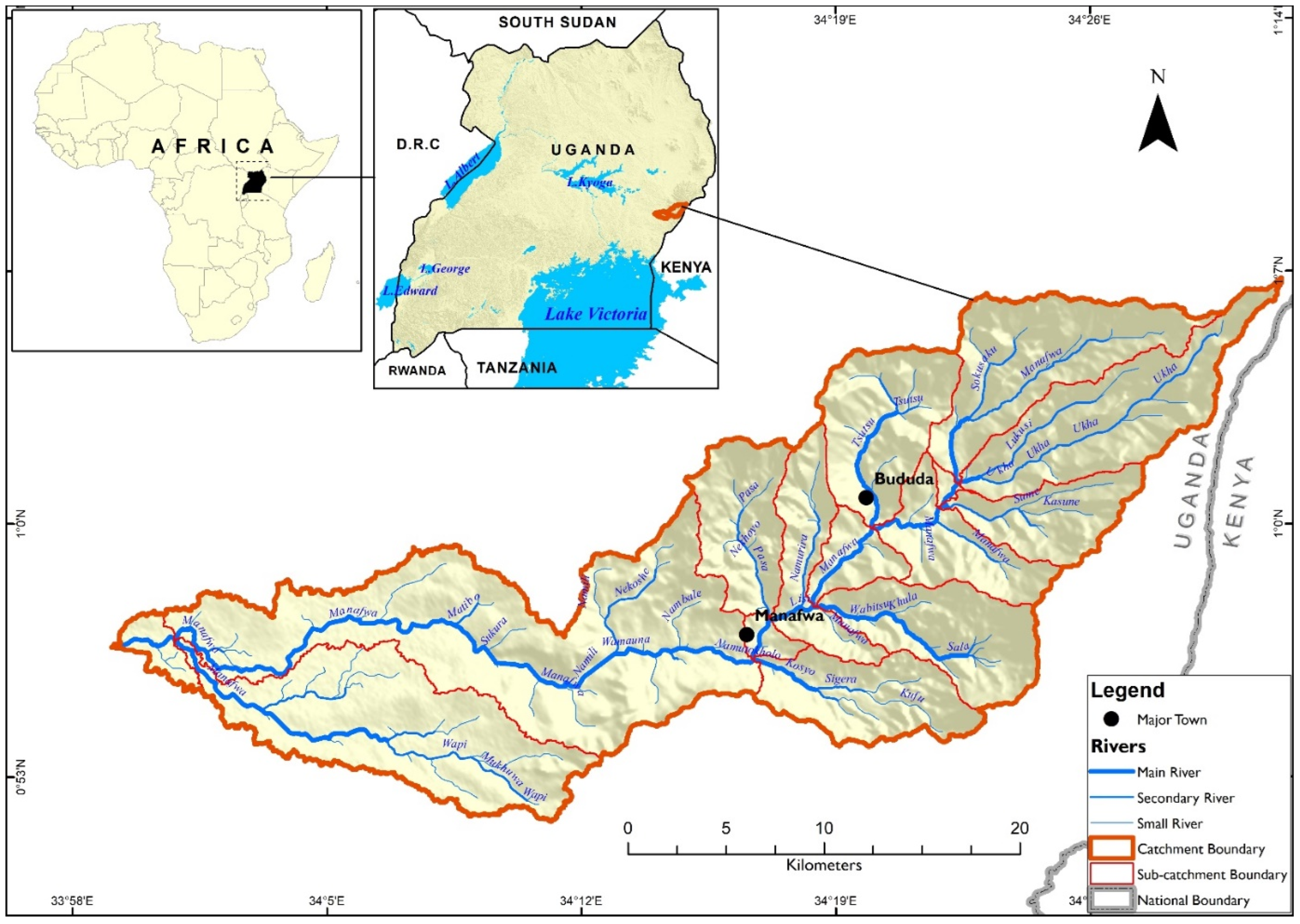
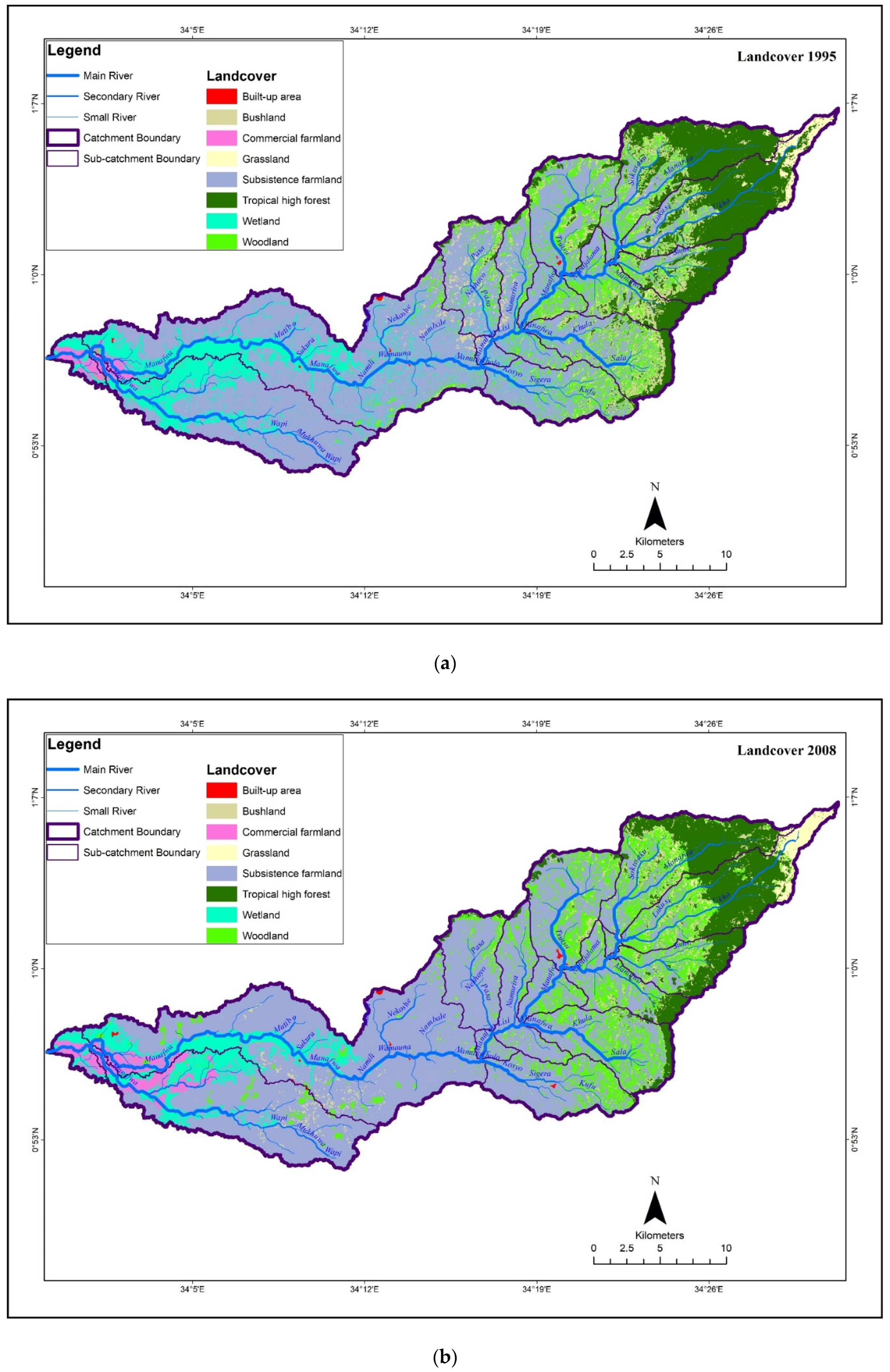
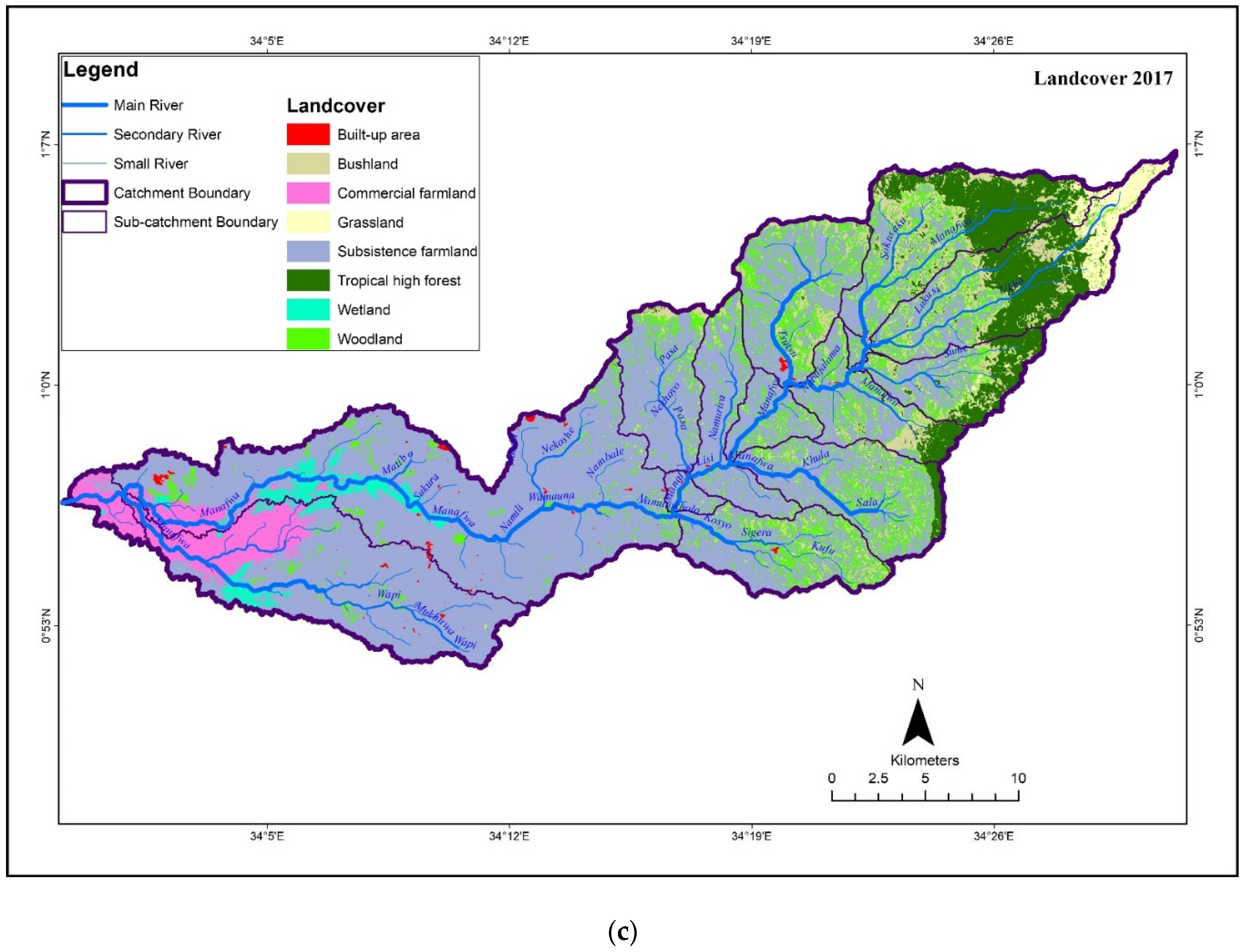

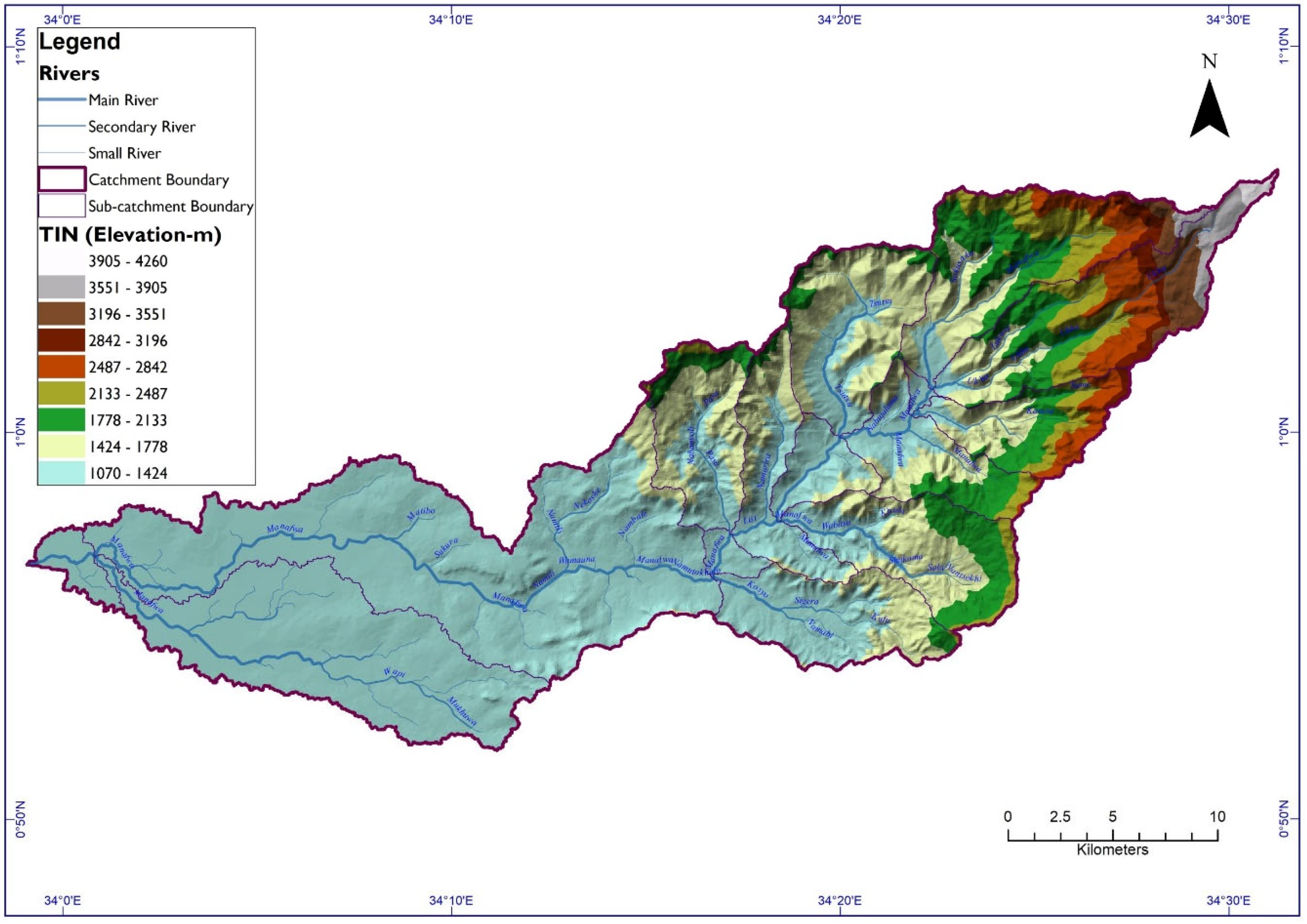
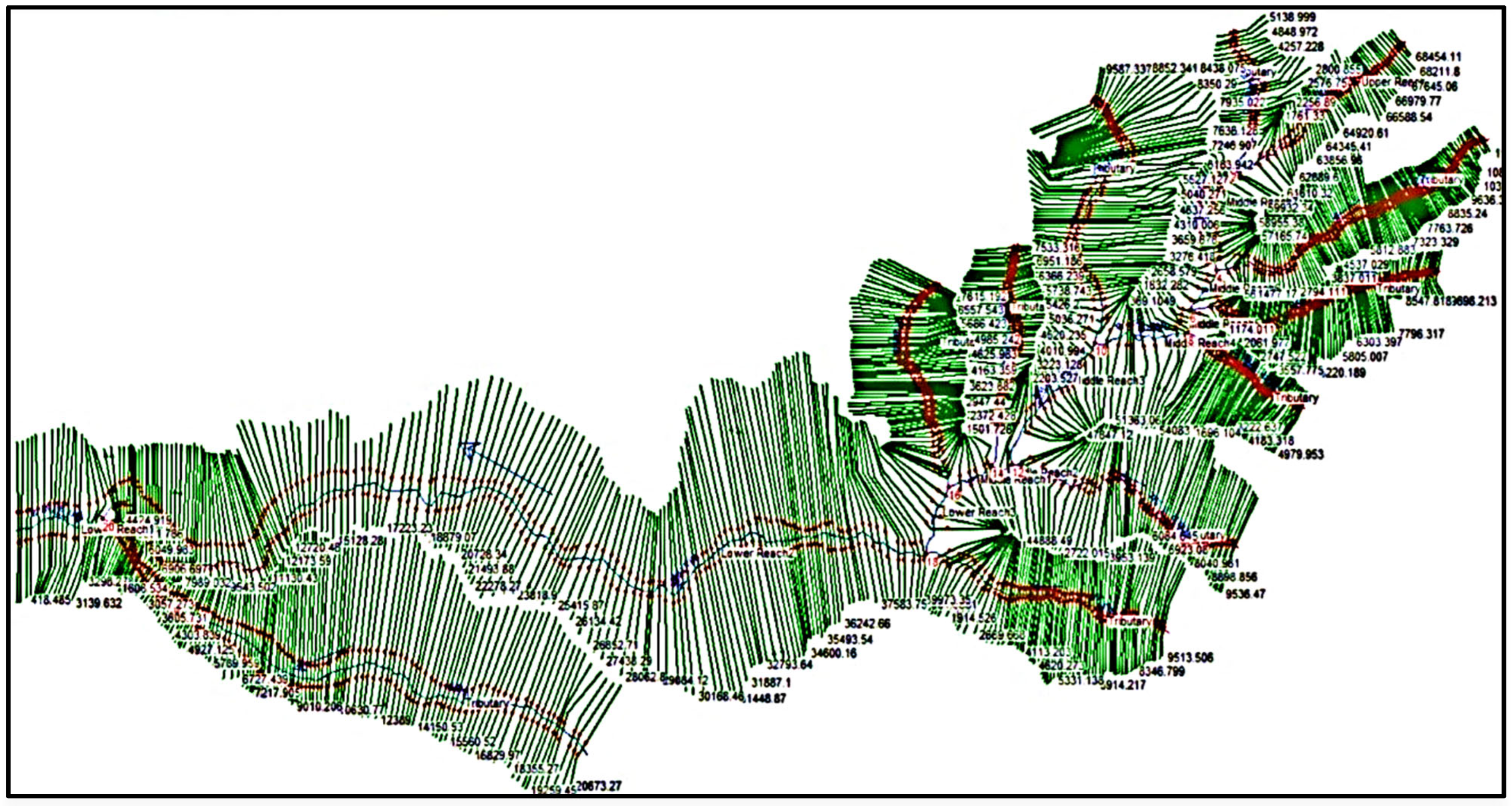
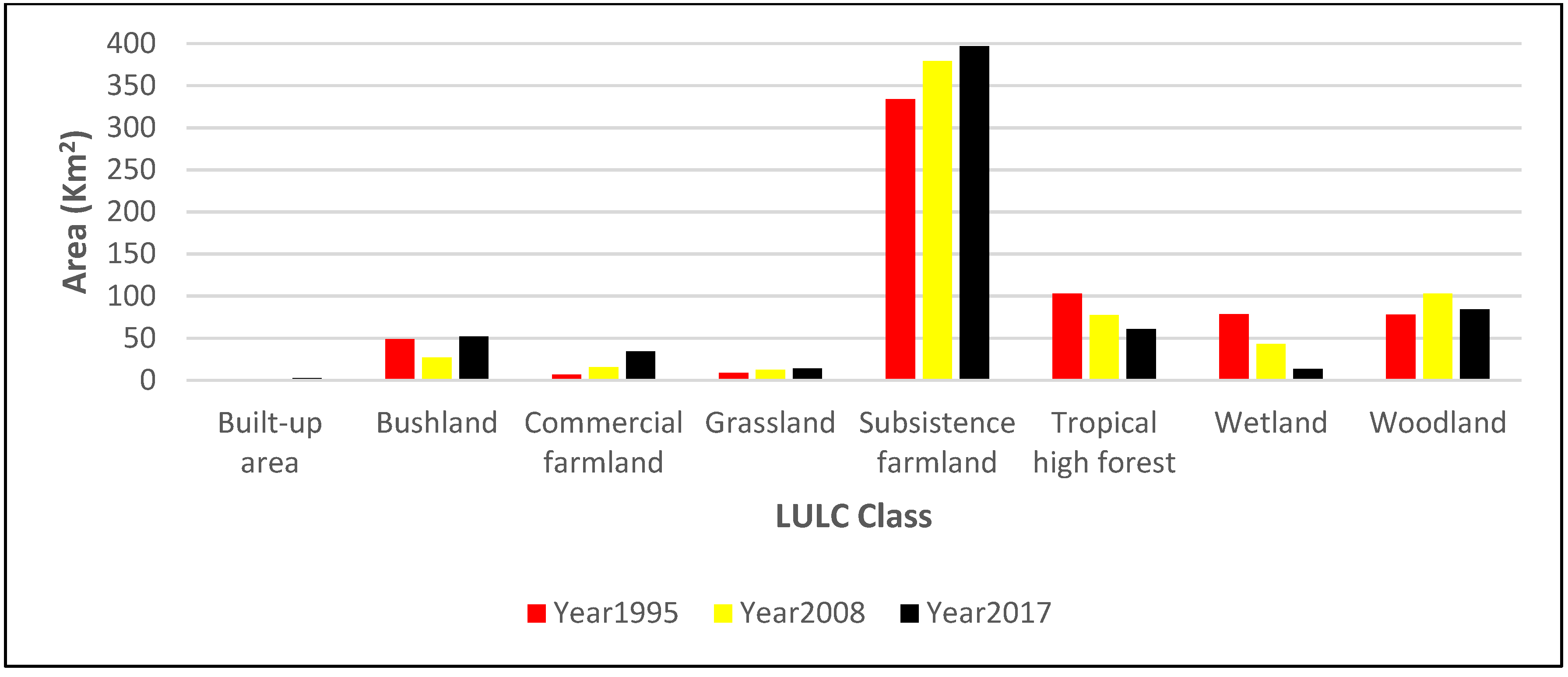
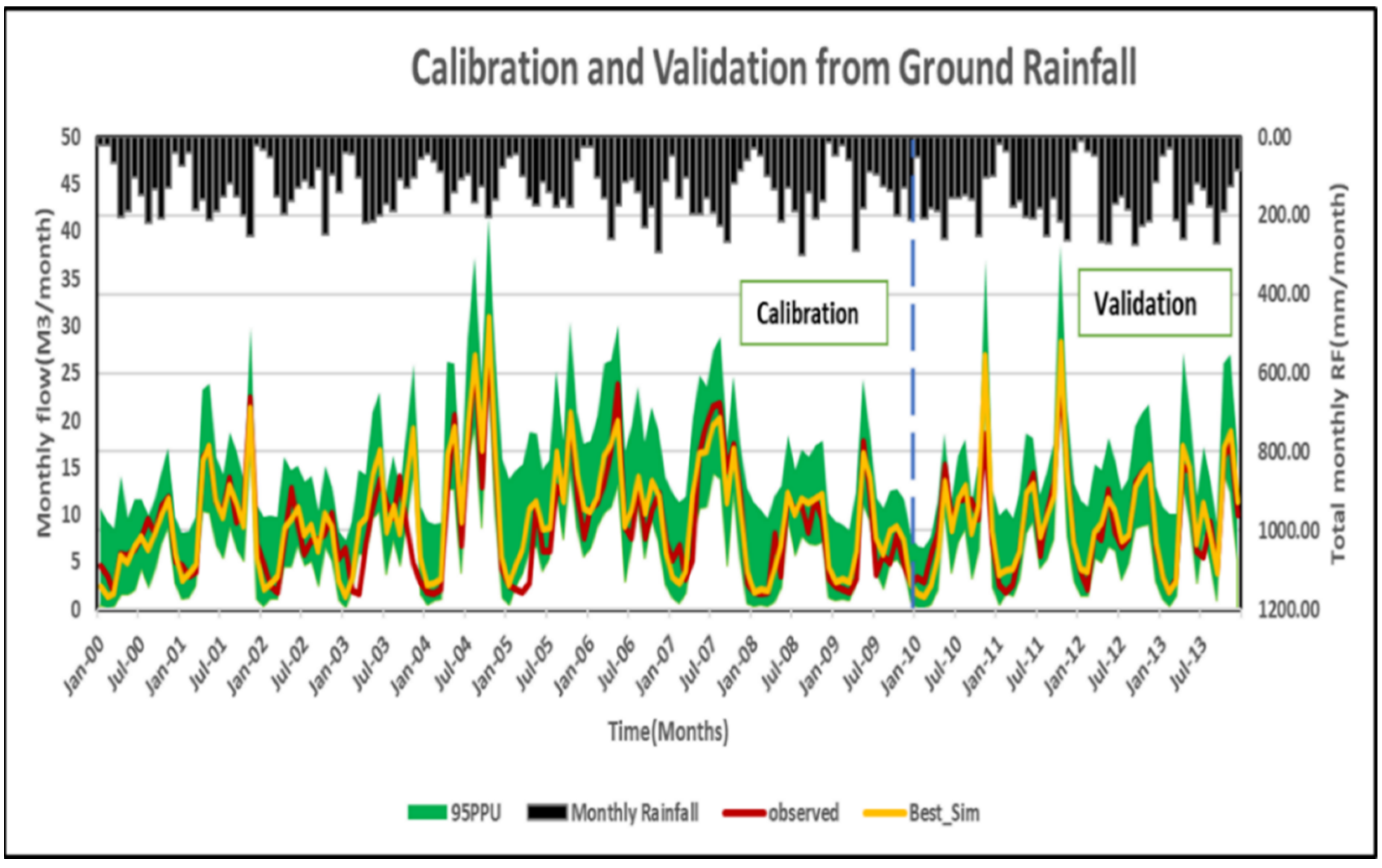
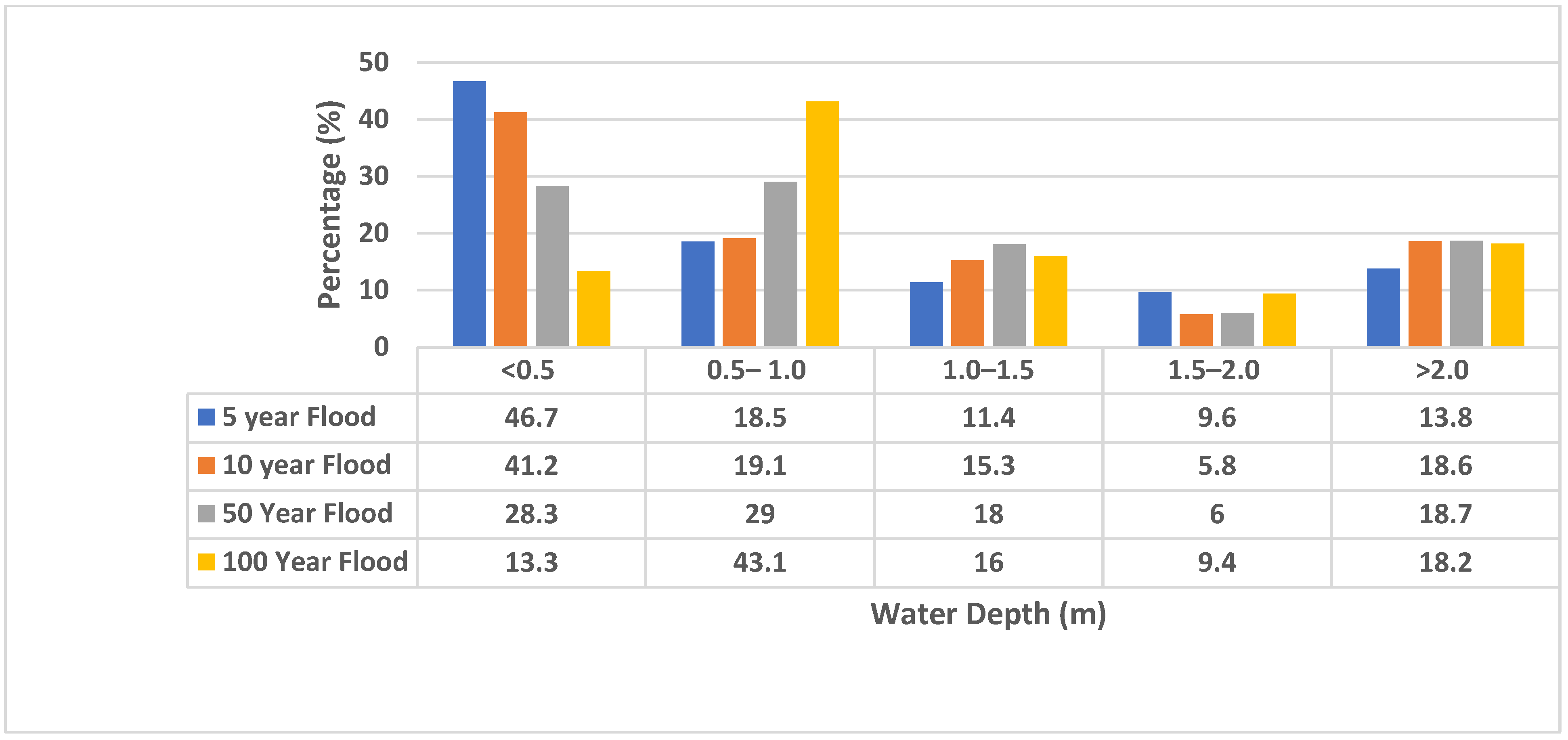
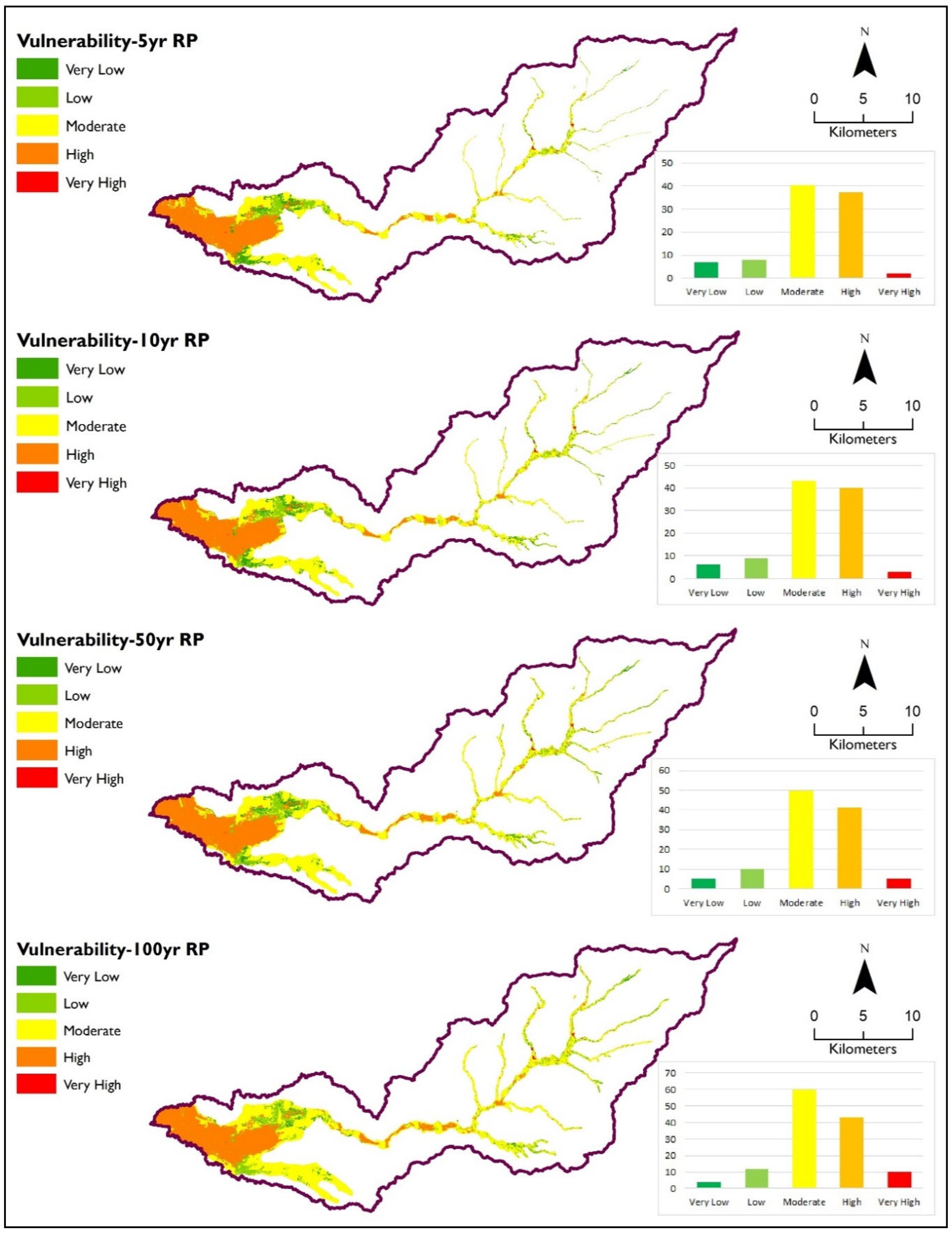
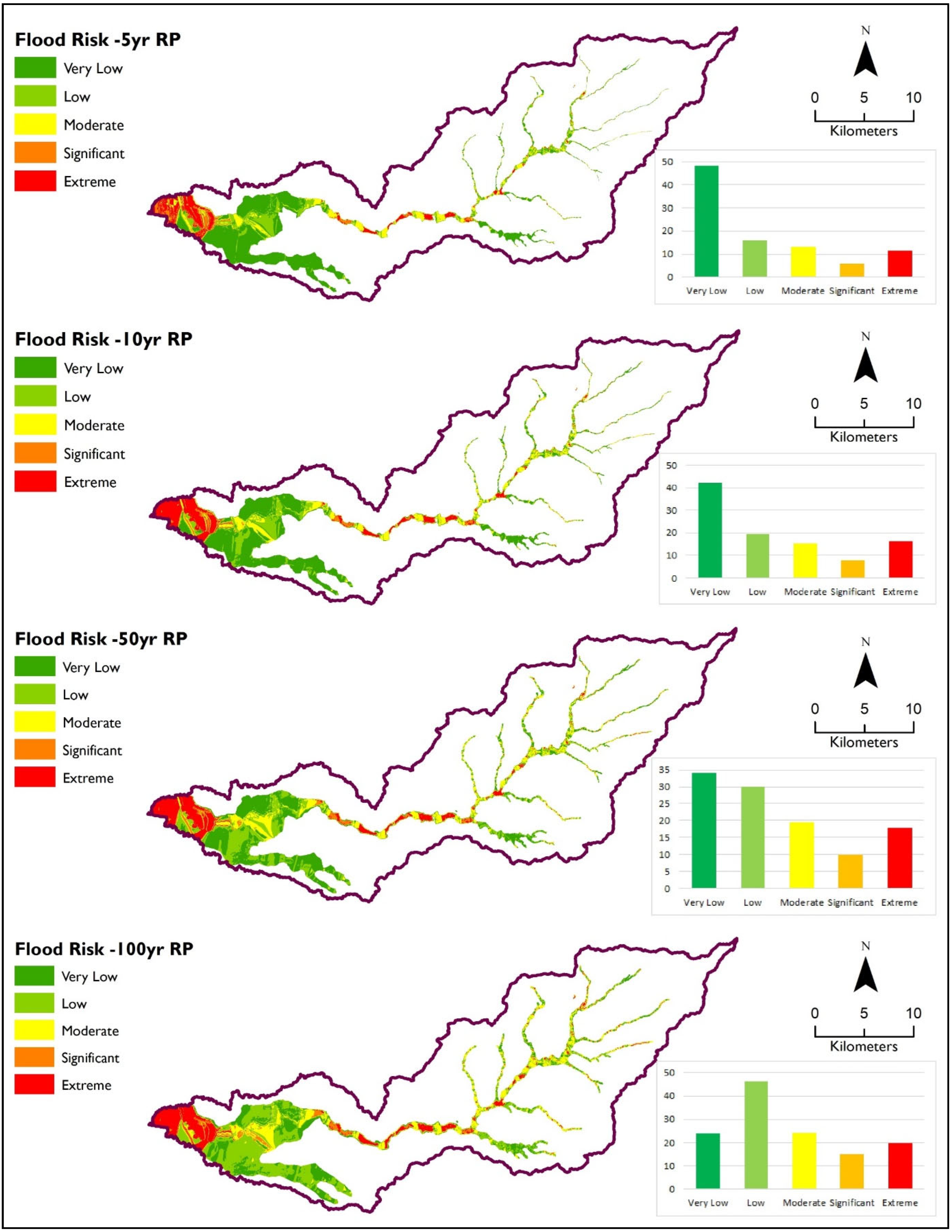
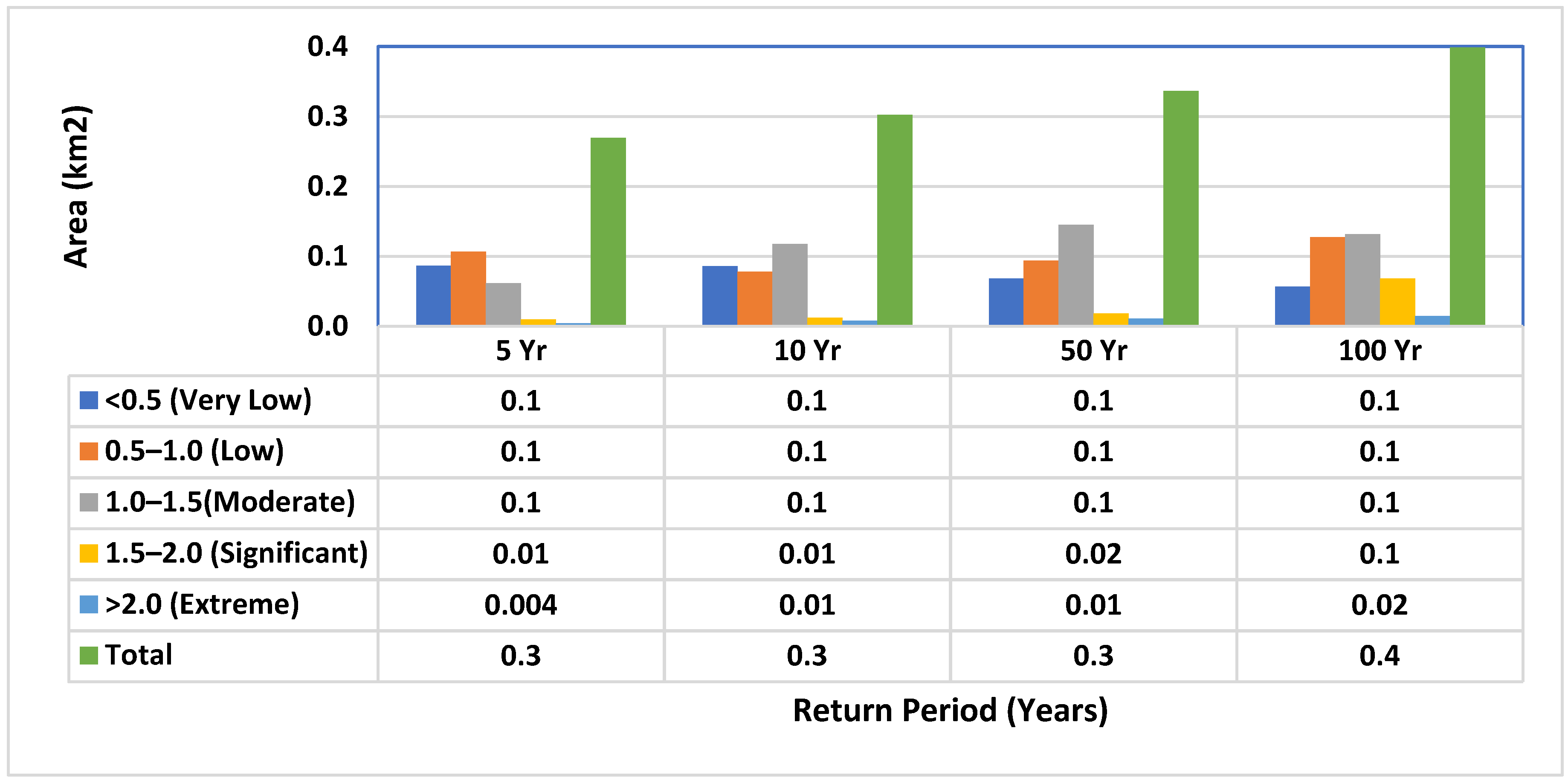
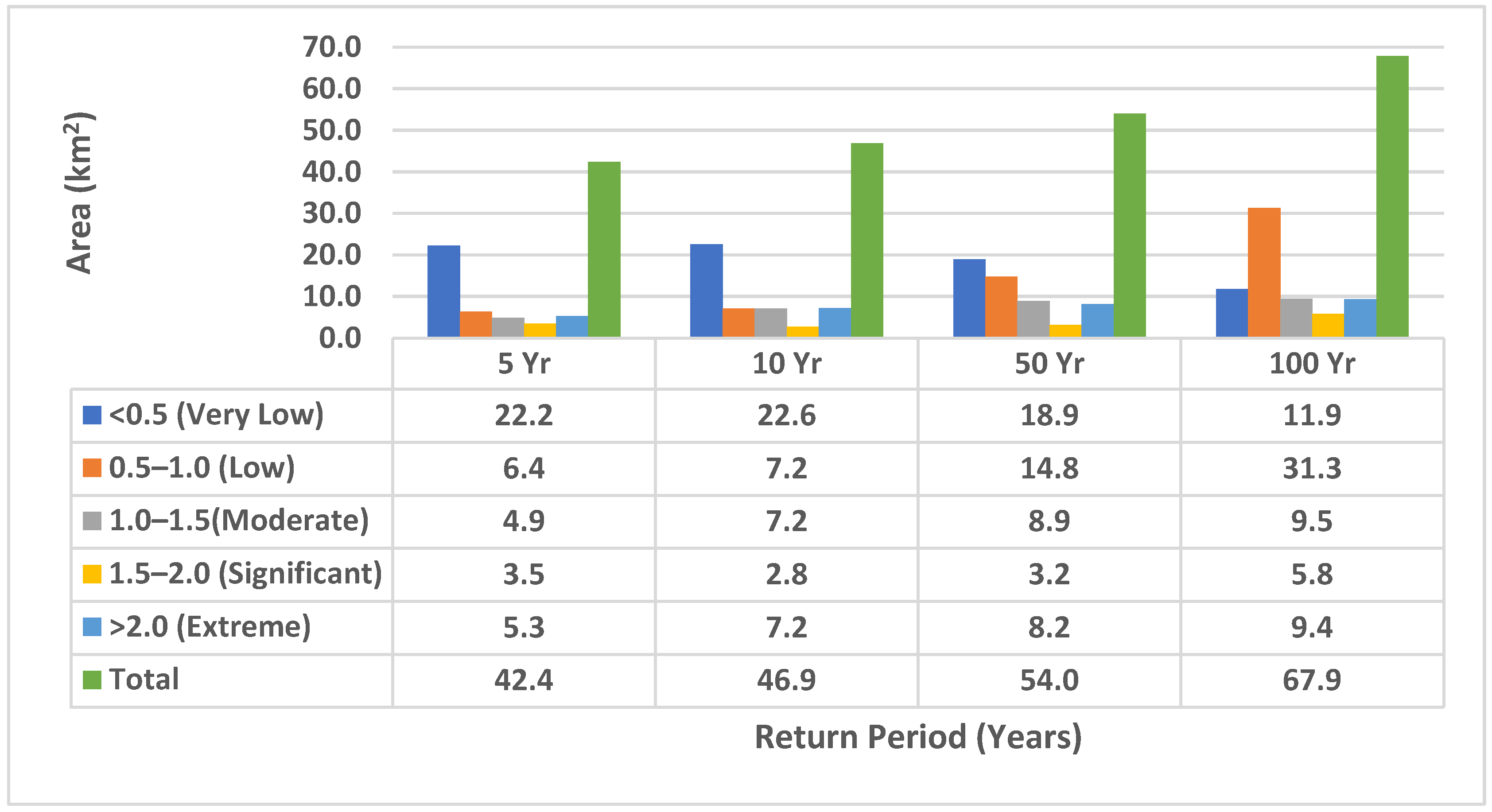
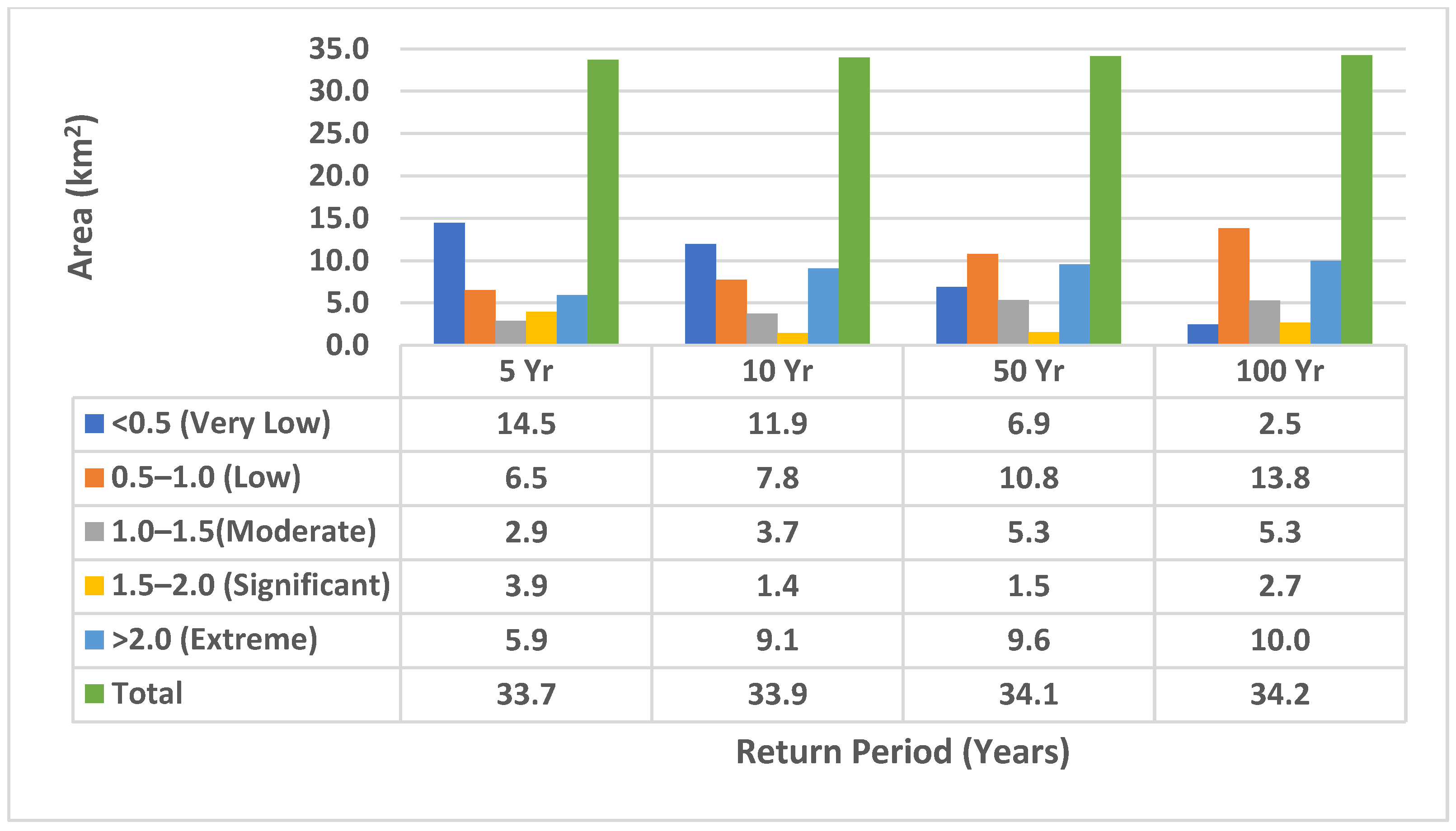
| Satellite | Sensor | Path/Row | Date of Acquisition |
|---|---|---|---|
| Landsat 4–5 | TM | 171/059 | 2 April 1995 |
| Landsat 7 | ETM | 171/059 | 12 March 2008 |
| Landsat 8 OLI/TIRS | LANDSAT 8 | 171/059 | 14 April 2017 |
| Flood Risk Value | Risk Class (RC) | Risk Level (RL) |
|---|---|---|
| <0.5 | 1 | Very Low |
| 0.5–1.0 | 2 | Low |
| 1.0–1.5 | 3 | Moderate |
| 1.5–2.0 | 4 | Significant |
| >2.0 | 5 | Extreme |
| No | Parameter Name | Definition | Fitted Value | Min Value | Max Value | t-Stat |
|---|---|---|---|---|---|---|
| 1 | R__CN2.mgt | Initial SCS runoff curve number for moisture condition II | −0.24 | −0.4 | 0.2 | 0.53 |
| 2 | V__ALPHA_BF.gw | Baseflow alpha factor (days) | 1.52 | 1.04 | 1.55 | 0.09 |
| 3 | V__GW_DELAY.gw | Groundwater delay time (days) | 35.26 | −50.05 | 98.83 | 17.11 |
| 4 | V__GWQMN.gw | Threshold depth of water in the shallow aquifer | −0.63 | −0.77 | 0.12 | −0.54 |
| 5 | R__LAT_SED.hru | Sediment concentration in later and groundwater flow (mg/L) | 59.56 | 43.68 | 74.52 | −0.96 |
| 6 | R__SOL_AWC(..).sol | Available water capacity of the soil layer (mm/mm) | −0.30 | −0.49 | −0.06 | −0.44 |
| 7 | R__CH_K2.rte | Effective hydraulic conductivity in main channel alluvium (mm/h) | 46.80 | 1.07 | 62.45 | −1.53 |
| 8 | R__CH_N2.rte | Manning’s “n” value for the main channel | 0.05 | 0.05 | 0.12 | 0.55 |
| 9 | R__ESCO.hru | Soil evaporation compensation factor | −0.04 | −0.05 | 0.50 | 0.15 |
| 10 | R__OV_N.hru | Manning’s “n” value for overland flow | 16.04 | 6.49 | 16.88 | 0.56 |
| 11 | R__SURLAG.bsn | Surface runoff lag coefficient | 15.19 | 12.34 | 17.29 | 0.91 |
| 12 | R__RCHRG_DP.gw | Deep aquifer percolation factor | 1.29 | 0.92 | 1.42 | 0.10 |
| 13 | R__GW_REVAP.gw | Groundwater “revap” coefficient | 0.47 | 0.28 | 0.76 | 1.72 |
| 14 | R__SOL_K(..).sol | Saturated hydraulic conductivity (mm/h) | 3.37 | 3.06 | 5.81 | −2.94 |
| Performance Criteria | Calibration (2000–2010) | Validation (2011–2013) | Accepted Range [24]. | ||||
|---|---|---|---|---|---|---|---|
| 1995 LC | 2008 LC | 2017 LC | 1995 LC | 2008 LC | 2017 LC | ||
| R2 | 0.94 | 0.79 | 0.94 | 0.81 | 0.78 | 0.79 | R2 > 0.50 |
| NSE | 0.65 | 0.79 | 0.74 | −1.72 | 0.69 | 0.69 | NSE > 0.50 |
| PBIAS | −30.2 | −12 | −23.4 | −68.8 | −14.6 | −11.7 | PBIAS ≤ ±25% |
| Land Cover Type | Area (km2) | Area (km2) | Area (km2) | % Change | % Change | % Change |
|---|---|---|---|---|---|---|
| 1995 | 2008 | 2017 | 1995–2008 | 2008–2017 | 1995–2017 | |
| Built-up area | 0.0 | 0.1 | 0.3 | 200.0 | ||
| Bushland | 2.0 | 1.8 | 3.2 | −10.0 | 77.8 | 60.0 |
| Commercial farmland | 6.8 | 15.7 | 34.2 | 130.9 | 117.8 | 402.9 |
| Grassland | 0.0 | 0.1 | 0.01 | −90.0 | ||
| Subsistence farmland | 57.3 | 65.5 | 67.9 | 14.3 | 3.7 | 18.5 |
| Tropical high forest | 1.5 | 1.2 | 1.1 | −20.0 | −8.3 | −26.7 |
| Wetland | 53.4 | 35.8 | 12.3 | −33.0 | −65.6 | −77.0 |
| Woodland | 7.7 | 8.5 | 9.7 | 10.4 | 14.1 | 26.0 |
Publisher’s Note: MDPI stays neutral with regard to jurisdictional claims in published maps and institutional affiliations. |
© 2022 by the authors. Licensee MDPI, Basel, Switzerland. This article is an open access article distributed under the terms and conditions of the Creative Commons Attribution (CC BY) license (https://creativecommons.org/licenses/by/4.0/).
Share and Cite
Erima, G.; Kabenge, I.; Gidudu, A.; Bamutaze, Y.; Egeru, A. Differentiated Spatial-Temporal Flood Vulnerability and Risk Assessment in Lowland Plains in Eastern Uganda. Hydrology 2022, 9, 201. https://doi.org/10.3390/hydrology9110201
Erima G, Kabenge I, Gidudu A, Bamutaze Y, Egeru A. Differentiated Spatial-Temporal Flood Vulnerability and Risk Assessment in Lowland Plains in Eastern Uganda. Hydrology. 2022; 9(11):201. https://doi.org/10.3390/hydrology9110201
Chicago/Turabian StyleErima, Godwin, Isa Kabenge, Antony Gidudu, Yazidhi Bamutaze, and Anthony Egeru. 2022. "Differentiated Spatial-Temporal Flood Vulnerability and Risk Assessment in Lowland Plains in Eastern Uganda" Hydrology 9, no. 11: 201. https://doi.org/10.3390/hydrology9110201
APA StyleErima, G., Kabenge, I., Gidudu, A., Bamutaze, Y., & Egeru, A. (2022). Differentiated Spatial-Temporal Flood Vulnerability and Risk Assessment in Lowland Plains in Eastern Uganda. Hydrology, 9(11), 201. https://doi.org/10.3390/hydrology9110201









